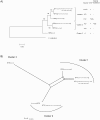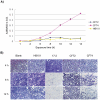Isolation and characterization of cytotoxic, aggregative Citrobacter freundii
- PMID: 22470435
- PMCID: PMC3310003
- DOI: 10.1371/journal.pone.0033054
Isolation and characterization of cytotoxic, aggregative Citrobacter freundii
Abstract
Citrobacter freundii is an infrequent but established cause of diarrhea in humans. However, little is known of its genetic diversity and potential for virulence. We analyzed 26 isolates, including 12 from human diarrheal patients, 2 from human fecal samples of unknown diarrheal status, and 12 from animals, insects, and other sources. Pulsed field gel electrophoresis using XbaI allowed us to divide the 26 isolates into 20 pulse types, while multi-locus sequence typing using 7 housekeeping genes allowed us to divide the 26 isolates into 6 sequence types (STs) with the majority belonging to 4 STs. We analyzed adhesion and cytotoxicity to HEp-2 cells in these 26 strains. All were found to adhere to HEp-2 cells. One strain, CF74, which had been isolated from a goat, showed the strongest aggregative adhesion pattern. Lactate dehydrogenase (LDH) released from HEp-2 cells was evaluated as a measure of cytotoxicity, averaging 7.46%. Strain CF74 induced the highest level of LDH, 24.3%, and caused >50% cell rounding, detachment, and death. We named strain CF74 "cytotoxic and aggregative C. freundii." Genome sequencing of CF74 revealed that it had acquired 7 genomic islands, including 2 fimbriae islands and a type VI secretion system island, all of which are potential virulence factors. Our results show that aggregative adherence and cytotoxicity play an important role in the pathogenesis of C. freundii.
Conflict of interest statement
Figures






References
-
- Scavia G, Staffolani M, Fisichella S, Striano G, Colletta S, et al. Enteroaggregative Escherichia coli associated with a foodborne outbreak of gastroenteritis. J Med Microbiol. 2008;57:1141–1146. - PubMed
-
- Guerrant RL, Dickens MD, Wenzel RP, Kapikian AZ. Toxigenic bacterial diarrhea: nursery outbreak involving multiple bacterial strains. J Pediatr. 1976;89:885–891. - PubMed
Publication types
MeSH terms
Substances
LinkOut - more resources
Full Text Sources

